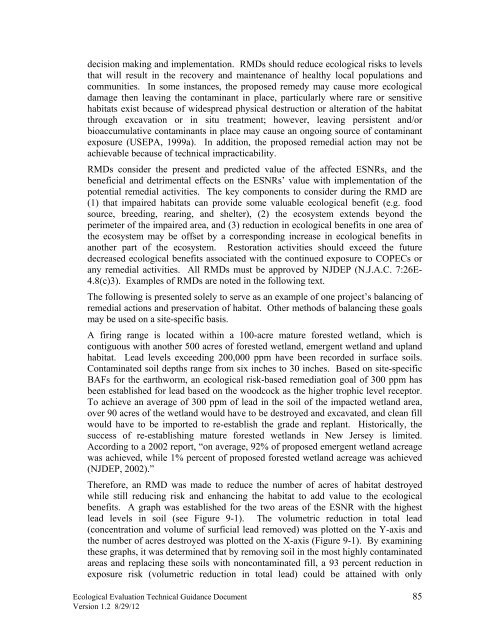Ecological Evaluation Technical Guidance - State of New Jersey
Ecological Evaluation Technical Guidance - State of New Jersey
Ecological Evaluation Technical Guidance - State of New Jersey
- No tags were found...
Create successful ePaper yourself
Turn your PDF publications into a flip-book with our unique Google optimized e-Paper software.
decision making and implementation. RMDs should reduce ecological risks to levelsthat will result in the recovery and maintenance <strong>of</strong> healthy local populations andcommunities. In some instances, the proposed remedy may cause more ecologicaldamage then leaving the contaminant in place, particularly where rare or sensitivehabitats exist because <strong>of</strong> widespread physical destruction or alteration <strong>of</strong> the habitatthrough excavation or in situ treatment; however, leaving persistent and/orbioaccumulative contaminants in place may cause an ongoing source <strong>of</strong> contaminantexposure (USEPA, 1999a). In addition, the proposed remedial action may not beachievable because <strong>of</strong> technical impracticability.RMDs consider the present and predicted value <strong>of</strong> the affected ESNRs, and thebeneficial and detrimental effects on the ESNRs’ value with implementation <strong>of</strong> thepotential remedial activities. The key components to consider during the RMD are(1) that impaired habitats can provide some valuable ecological benefit (e.g. foodsource, breeding, rearing, and shelter), (2) the ecosystem extends beyond theperimeter <strong>of</strong> the impaired area, and (3) reduction in ecological benefits in one area <strong>of</strong>the ecosystem may be <strong>of</strong>fset by a corresponding increase in ecological benefits inanother part <strong>of</strong> the ecosystem. Restoration activities should exceed the futuredecreased ecological benefits associated with the continued exposure to COPECs orany remedial activities. All RMDs must be approved by NJDEP (N.J.A.C. 7:26E-4.8(c)3). Examples <strong>of</strong> RMDs are noted in the following text.The following is presented solely to serve as an example <strong>of</strong> one project’s balancing <strong>of</strong>remedial actions and preservation <strong>of</strong> habitat. Other methods <strong>of</strong> balancing these goalsmay be used on a site-specific basis.A firing range is located within a 100-acre mature forested wetland, which iscontiguous with another 500 acres <strong>of</strong> forested wetland, emergent wetland and uplandhabitat. Lead levels exceeding 200,000 ppm have been recorded in surface soils.Contaminated soil depths range from six inches to 30 inches. Based on site-specificBAFs for the earthworm, an ecological risk-based remediation goal <strong>of</strong> 300 ppm hasbeen established for lead based on the woodcock as the higher trophic level receptor.To achieve an average <strong>of</strong> 300 ppm <strong>of</strong> lead in the soil <strong>of</strong> the impacted wetland area,over 90 acres <strong>of</strong> the wetland would have to be destroyed and excavated, and clean fillwould have to be imported to re-establish the grade and replant. Historically, thesuccess <strong>of</strong> re-establishing mature forested wetlands in <strong>New</strong> <strong>Jersey</strong> is limited.According to a 2002 report, “on average, 92% <strong>of</strong> proposed emergent wetland acreagewas achieved, while 1% percent <strong>of</strong> proposed forested wetland acreage was achieved(NJDEP, 2002).”Therefore, an RMD was made to reduce the number <strong>of</strong> acres <strong>of</strong> habitat destroyedwhile still reducing risk and enhancing the habitat to add value to the ecologicalbenefits. A graph was established for the two areas <strong>of</strong> the ESNR with the highestlead levels in soil (see Figure 9-1). The volumetric reduction in total lead(concentration and volume <strong>of</strong> surficial lead removed) was plotted on the Y-axis andthe number <strong>of</strong> acres destroyed was plotted on the X-axis (Figure 9-1). By examiningthese graphs, it was determined that by removing soil in the most highly contaminatedareas and replacing these soils with noncontaminated fill, a 93 percent reduction inexposure risk (volumetric reduction in total lead) could be attained with only<strong>Ecological</strong> <strong>Evaluation</strong> <strong>Technical</strong> <strong>Guidance</strong> Document 85Version 1.2 8/29/12
















